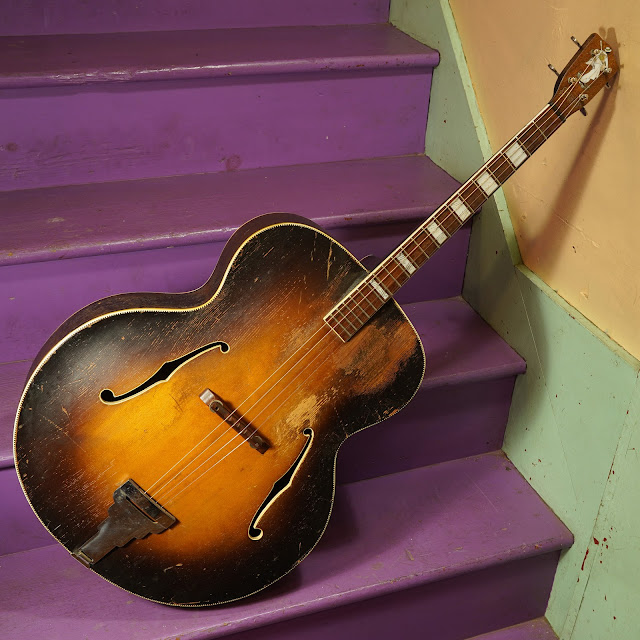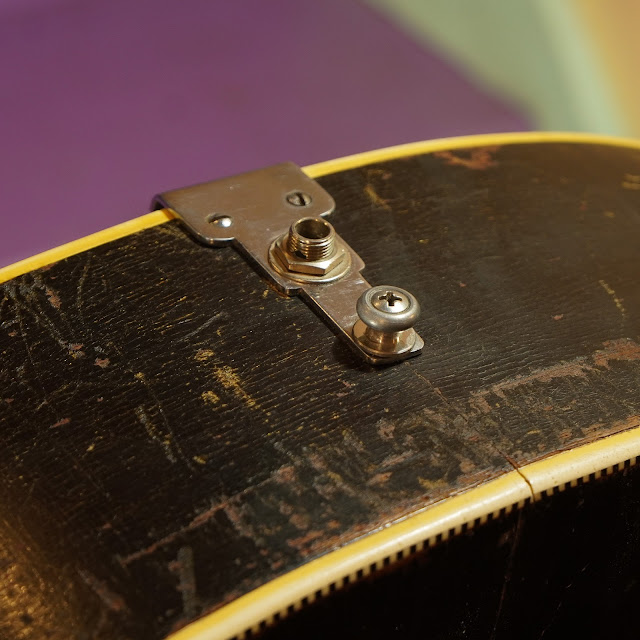1930s Regal "Prince" Carved-top Tenor Guitar
Update 2022: my buddy Rick is trading this along to the next owner, and so I had it in-shop for a quick setup, new ebony nut, and restring before shipping-off for him. I've updated the photos, added a video, and updated the description where necessary... now back to the post...
What the heck am I doing working on my off-day? Well, my friend Rick picked this up a few weeks ago and told me about this thrift-store score the same day. He'd been meaning to drop it off ever since and when he came by yesterday I was pretty excited to see it. I had an hour left in my Sunday work schedule so I reset the neck and then did the fret level/dress, cleaning-up, and setup-side of things today. His having a number of other instruments on the waiting-list for repair meant it was easier for me to slip it into the schedule and not feel guilty, too.
Post-work, this is a ballsy, punchy, full-on tenor that absolutely suits what it was made for: chordal, big-band, backing work. It cuts a nice lead, too, but sounds ferocious for chord-chopping.
These high-grade, carved-top/back Regal archtops are extremely scarce and this one is a tenor... and 18" wide on the lower bout! It appears to be the company's tenor version of their "Prince" model and has the sunburst, checker binding, and bound f-holes to match. The fancy-pants, fully-carved Regals of this ilk appear to have been introduced in 1938 and I have my suspicions that this was actually built around 1940 due to that tailpiece design.
The top is solid, carved spruce. The back and sides are solid mahogany and the back is carved as well.
The prettiest bit on these is the inlaid, multicolor pearl, "minstrel" figure at the headstock. Also note that the routed "Regal" script up there would have originally been filled-in with gold sparkle, too. Styling!
This came in with a seriously-gross neck joint. Someone had installed a giant wood screw right through the rear of the heel (I'm guilty of it, from time to time, but I like to tidy it) and upon removing that and getting at the joint itself, I found an absolute mess of old shim-up repairs.
Part of the reason I usually remove fretboard extensions when doing resets on a lot of Chicago-made/lower-end guitars is because the joints weren't made all that well to begin-with. For example: when I reset this neck I aligned it with the center-seam of the top and the endblock area, but found that Regal had installed the tailpiece off-center from the factory! The problems are then compounded by folks who just cram stuff in there willy-nilly in hopes of tightening the joint up.
To fix something funky like this mess, I needed to build it up/shim it up again in a similar wonkified manner -- but I make sure that when I do it that the joint is stable, rigid, and "ready for tension" without glue. It means that the necks stay where I've put them rather than coming-up after a few years because I did a "blind" glue/shim job under a fretboard extension's overhang and just guessed about it.
This instrument was heavily-played and I was lucky to have enough meat on the frets left to give it a proper level/dress job rather than a refret. Due to the abuses of time, however, much of the fretboard inlay has lost its recessed pigment so you can't see the interesting "leafy" bits.
I love the "checker" purfling/binding combo. The bound, narrow, f-holes are also gorgeous.
This has a tonebar-braced top.
The bridge had been a little cut-down over time and had some worn string slots. I adjusted the compensation a bit to make-up for the wear and tear. Post-reset, this has plenty of height and adjustment-room.
The heavy-duty tailpiece has one flaw: it wasn't really the right one to choose for the tenor neck. Its length means that, due to the bridge location, its height over the body was questionable (it only had about 2mm of airspace left under its leading edge before it hit the top) and so added a little "bumper" under it near the hinge to pop it up off the top a little more.
I might as well mention that the instrument is almost entirely crack-free (there's a glued-up hairline on the side) and all-original save its endpin. It's missing its pickguard and brackets, though.
The mahogany back and sides, true to many Regal products, have some nice fine curly figure throughout. The neck appears to be a 5-piece job of mixed mahogany and walnut, perhaps?
Repairs included: in 2016 -- a neck reset, fret level/dress, bridge work, cleaning, setup, etc. -- in 2022, just a cleaning, setup, and replacement ebony nut.
Top wood: solid spruce
Back & sides wood: solid figured mahogany
Bracing type: 2 tonebars
Bridge: rosewood adjustable, comp'd for 2-wound, 2-plain (DGBE tuning)
Fretboard: rosewood
Neck wood: mahogany/walnut or maple?
Action height at 12th fret: 1/16" overall (fast)
String gauges: 36w, 26w, 17, 13 for DGBE tuning
Neck shape: medium-big C/V
Board radius: flat
Neck relief: straight
Fret style: medium-low
Scale length: 23"
Nut width: 1 5/16"
Body width: 17 7/8"
Body depth: 4" + arching
Weight: 4 lbs 15 oz



















Comments
Possibly be convinced to part with it..